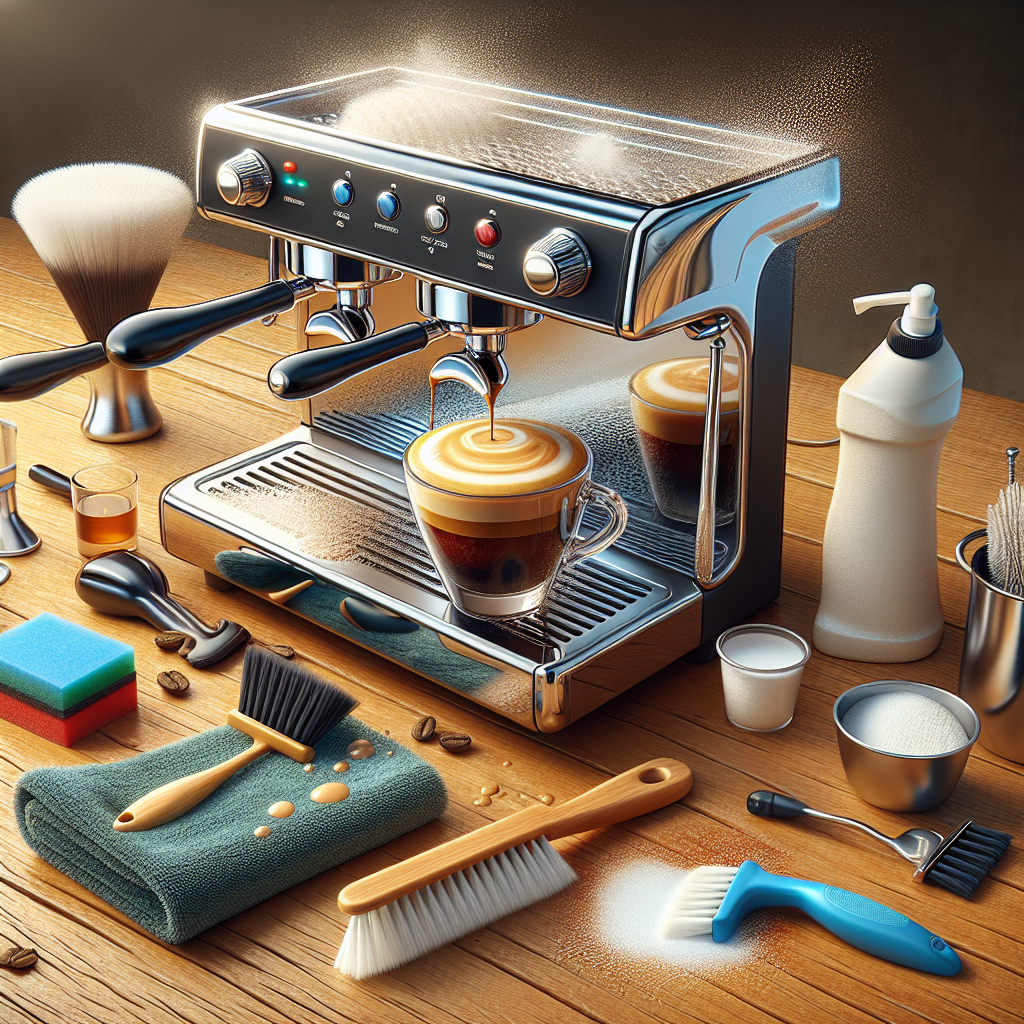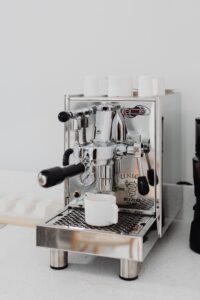
Making Every Shot Count: PID Espresso Machine Cleanliness
Every espresso lover knows that the secret to a perfect shot is not just in the beans or the machine; it’s also in the cleanliness of the equipment. A PID-controlled espresso machine is a pinnacle of precision, but without proper care, it can quickly become a source of frustration. Let’s make sure every shot you pull is a masterpiece of flavor and aroma.
Key Takeaways
-
Cleanliness is crucial for the optimal performance of your PID espresso machine.
-
Regular maintenance prevents flavor taint and ensures machine longevity.
-
Understanding the key components of your machine is essential for effective cleaning.
-
Backflushing and descaling are fundamental practices for a clean machine.
-
A systematic cleaning schedule can save you time and money on repairs.
Unlocking the Full Potential of Your PID Espresso Machine
Think of your PID espresso machine as a high-performance car. It’s designed to deliver power and precision, but it needs regular tune-ups to stay in top shape. By keeping it clean, you’re not just preserving its looks; you’re ensuring that every espresso shot is as flawless as the machine’s engineering intended.
Why Cleanliness is Your Espresso’s Best Friend

Coffee oils and residues can quickly turn rancid, affecting the taste of your espresso. Milk residues can spoil and clog your steam wand, and scale buildup from water can damage the delicate components of your machine. A clean machine is the foundation of a great espresso, and it’s a foundation we must lay with care.
Setting the Stage for Superb Espresso
Before we even start the cleaning process, it’s important to understand what makes your PID espresso machine tick. From the boiler to the group head, each component plays a critical role in the brewing process. Knowing these parts will help you target your cleaning efforts for the best results.
Taste, Longevity, and Performance: The Triple Win
Regular cleaning does more than just maintain the quality of your espresso; it extends the life of your machine and keeps it running smoothly. This means fewer breakdowns, less money spent on repairs, and more time enjoying your favorite coffee creations. It’s a win on all fronts.
Pre-Clean Checks: Gearing Up for a Spotless Machine

Before diving into the cleaning process, let’s do a quick pre-clean check. Ensure your machine is turned off and cooled down to avoid any accidents. Check the water reservoir for any visible impurities and remove old coffee grounds from the basket. Now, you’re ready to start the cleaning journey.
Gathering Your Cleaning Arsenal
Ready to roll up your sleeves? First, let’s gather the tools and cleaners you’ll need. A soft cloth, a non-abrasive scrub pad, a group head brush, and a commercial espresso machine cleaner like Cafiza are essentials. For descaling, you’ll want a descaling solution made specifically for espresso machines. And don’t forget a blind filter for backflushing!
Identifying Key Areas of Attention
Your espresso machine has several critical areas that require regular cleaning. The group head, where water dispenses into the portafilter, can harbor old coffee grounds and oils. The steam wand, used for frothing milk, is prone to milk residue buildup. The drip tray and the grinder also need regular attention to prevent old coffee and water from affecting your machine’s performance and hygiene.
Sparkling Exteriors: Wiping Down Your Espresso Workhorse

A clean exterior is just as important as the interior for your machine’s longevity and your own pride of ownership. Daily wipe-downs with a damp cloth can prevent buildup of dust and coffee splatters. For stainless steel surfaces, use a cleaner that’s designed for the material to avoid streaks and maintain that showroom shine.
Body and Finish: Keeping it Shiny
For the body of your machine, a gentle cleaner that won’t scratch or dull the finish is key. Remember to unplug the machine and let it cool before you start. Use a soft, damp cloth to wipe down the surface, and for any stubborn spots, a little bit of elbow grease with a non-abrasive scrub pad will do the trick.
The Steam Wand: Ensuring Clean Steam Every Time
The steam wand is a hotspot for bacteria if not cleaned properly. After each use, purge steam to blow out milk residue, then wipe the wand with a damp cloth. At the end of the day, soak the tip in warm water with a bit of cleaning solution, then scrub it gently with a cleaning brush. This ensures that your wand stays clean and ready for frothy goodness.
The Inner Sanctum: Deep Cleaning the Boiler and Group Head

Deep cleaning the boiler and group head is a task that’s often overlooked, but it’s vital for the health of your machine. Over time, mineral deposits from water can build up inside the boiler, affecting temperature stability and taste. The group head needs attention to remove coffee oil residue and old grounds.
Descaling: The What, The Why, and The How
Descaling is the process of removing those pesky mineral deposits from your machine’s boiler and water passages. It’s essential because scale buildup can lead to reduced water flow, changes in brewing temperature, and eventually, machine failure. Use a descaling solution according to the manufacturer’s instructions, run it through the machine, and then flush thoroughly with fresh water. This keeps your machine’s inner workings as fresh as the day it was made.
Group Head Glory: Clearing Out Coffee Gunk
The group head is where your coffee’s journey begins, and keeping it clean is essential for a perfect espresso shot. Over time, coffee particles and oils can clog the screen and shower head, leading to uneven extraction and a subpar brew. A dedicated group head brush and a bit of daily scrubbing can work wonders in keeping this vital area pristine.
Filter Finesse: Portafilter and Basket Deep Dive

The portafilter and basket are in direct contact with your coffee grounds, making them critical to your machine’s cleanliness. The residue left in these components can impart unwanted flavors into your espresso and obstruct the flow of water. It’s time to give these parts the attention they deserve.
Soaking and Scrubbing Techniques
For a thorough clean, disassemble the basket from the portafilter and soak both in hot water mixed with a specialized espresso machine cleaner. After a good soak, use a brush to scrub away any lingering coffee particles. Rinse them well with clean water and dry them before reassembling. Your coffee will thank you with every pure, untainted sip.
When to Replace: Reading the Signs
Even with the best care, portafilter baskets and screens will eventually wear out. Watch for signs like uneven espresso extraction or grounds in your cup. If the holes in the basket look misshapen or enlarged, it’s time for a new one. A fresh basket is a small investment for a consistently excellent espresso.
Backflushing Brilliance: An Essential Reset for Your Machine

Backflushing is like a reset button for your espresso machine, clearing out the coffee oils and particles that a regular rinse won’t budge. This process is specific to machines with a solenoid valve and is crucial for keeping the water paths clean.
The Simple Steps to Backflushing Success
To backflush, insert a blind filter into your portafilter, add a small amount of backflush cleaner, and lock it into the group head. Start the brew cycle for about 10 seconds, then stop and let the pressure release. Repeat this process several times until the water runs clear, and finish with a few plain water backflushes to rinse out any cleaner residue.
How Often Should You Backflush?
The frequency of backflushing depends on how much you use your machine. For heavy use, such as in a coffee shop, daily backflushing is recommended. At home, a weekly routine should suffice. Remember, consistency is key to maintaining the inner workings of your espresso machine and ensuring the longevity of each delicious shot.
Regular Refresh: Maintenance Must-Do’s for Peak Performance

Just like any high-precision tool, your PID espresso machine thrives on regular maintenance. It’s not just about cleaning; it’s about fine-tuning every part to work harmoniously. This regular refresh keeps your machine humming and your espresso tasting as fresh as the first cup you ever made.
Scheduled Servicing: Timing Your Tune-Ups
Mark your calendar for regular maintenance sessions. A monthly check-up is ideal for home users, while busy cafes might need weekly attention. During these sessions, inspect all moving parts, check for leaks, and listen for any unusual noises. Replace water filters as recommended by the manufacturer to prevent scale and ensure the purest water for your brews.
Seals and Gaskets: The Unsung Heroes
Seals and gaskets might not be glamorous, but they’re essential for a tight, leak-free machine. These components wear out over time, leading to leaks and loss of pressure. Check them regularly for any signs of wear or degradation. Replacing them is usually straightforward and can save you from more costly repairs down the line.
When Things Go Awry: Troubleshooting Common Hiccups

No matter how well you maintain your machine, you’re bound to encounter the occasional hiccup. The key is to address these issues promptly to prevent them from becoming bigger problems. Here’s how to troubleshoot some common issues.
Coffee Flow Woes: Quick Fixes
If your espresso flow is slow or inconsistent, start by checking the grind size. Too fine, and it can clog your machine; too coarse, and water rushes through too quickly. Ensure your portafilter basket is clean and not overfilled. If the problem persists, it could be time to descale or check for wear on your machine’s internal components.
Water Quality Warnings: Heeding the Signs
Water quality affects not just taste, but also the health of your machine. Hard water can lead to scale buildup, while water that’s too soft might not extract flavors effectively. Use a water test strip to check hardness levels and adjust your filtration system accordingly. This proactive step can prevent a multitude of issues and keep your espresso tasting great.
FAQ: Fine-Tuning Your Espresso Machine Maintenance

Got questions? You’re not alone. Maintaining an espresso machine can seem complex, but with the right knowledge, it’s a breeze. Here are answers to some frequently asked questions to help you keep your machine in tip-top shape.
How can I tell if my espresso machine needs descaling?
Look for signs like slower water flow, changes in coffee taste, or mineral deposits on machine parts. If your machine has a built-in water hardness setting and it alerts you, heed its warning. When in doubt, follow the manufacturer’s recommended descaling intervals.
Are there any cleaning solutions I should avoid using on my PID espresso machine?
Avoid using anything abrasive or with harsh chemicals. Stick to cleaners specifically designed for espresso machines, as they’re formulated to be effective without damaging sensitive components. Natural solutions like vinegar can be used for descaling, but ensure they’re rinsed thoroughly to avoid flavor contamination.
Can improper water affect my PID espresso machine’s performance?
Definitely, water with high mineral content can lead to scale, while impure water can introduce unwanted flavors and odors. Use filtered water or install a water-softening system to protect your machine and enhance your coffee’s taste.
What’s the best way to clean the steam wand without risking damage?
After each use, purge steam to expel any milk residue. Then, wipe the wand with a damp cloth. For a deeper clean, soak the tip in a water and cleaning solution mix, then use a small brush to gently remove any buildup. Always purge steam again after cleaning to clear out any remaining cleaner.
How do I replace my espresso machine’s group gasket and screen?
First, ensure your machine is turned off and cool. Remove the old gasket and screen, usually by prying them out with a flat-head screwdriver or a specialized tool. Clean the area thoroughly before fitting the new gasket and screen into place. If you’re unsure, consult your machine’s manual or a professional.
In conclusion, keeping your PID-controlled espresso machine clean and well-maintained is the cornerstone of brewing the perfect cup of espresso. It’s not just about preserving the machine’s life but also about ensuring the quality and taste of your coffee remain exceptional. Regular cleaning, backflushing, and descaling will prevent most issues, but always keep an eye out for any signs that your machine needs a little extra TLC. Remember, the effort you put into maintenance will be reflected in every delicious sip of your home-brewed espresso. Happy brewing!


